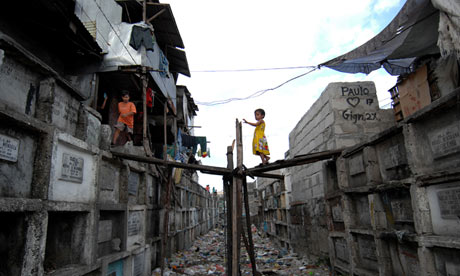
A child walks on a
makeshift bridge between shanty homes built on top of banks of tombs
inside the north Manila cemetery. Photograph: Noel Celis/AFP/Getty
Images
Every morning, Alberto Lagarda Evangelista, 71, leaves the
two-storey, lemon-yellow home he has lived in for the past decade and
walks to work at the cemetery next door. As a caretaker of about 20
graves, Evangelista earns just 20,000 pesos (£315) a year, a sum so
small that he must share his house with seven other people – all of whom
are dead.
Evangelista lives and works in the Cementerio del
Norte, a sprawling, 54-hectare green space in north Manila that is also
home to some 1,000 other families. Here in the
Philippines'
largest public graveyard, century-old tombs have been converted into
stalls selling sachets of shampoo and instant noodles, clothes lines are
strung between crosses and car batteries power radios, karaoke machines
and television sets. Evangelista's home is a mausoleum housing eight
graves. The breezy second storey where the owners pay their annual
respects to the dead doubles as his bedroom. "Just look at my view," he
says, pointing his cigarette out towards the grave-studded horizon.
Today,
the shady lanes are busy with the sundry activities of any normal
neighbourhood: a group of boys plays basketball; adults while away the
afternoon heat with sodas and playing cards; couples canoodle atop the
graves that double as their beds; and women prepare chicken
adobo in their mausoleum cafes.
The
cemetery's inhabitants rank among the poorest of the poor in Manila, a
capital where roughly 43% of the city's 13 million residents live in
informal settlements like this one, according to a 2011
Asian Development Bank report.
This Roman Catholic country has one of Asia's fastest growing
populations and a massive housing shortage – meaning that the urban poor
must usually find, build or cobble together housing anywhere there is
space: under bridges, along highways, in alleys, perched atop flood
channels, or even among the dead.
No one knows exactly when the
cemetery became a living village. But many of Manila North's 6,000-odd
residents were born here and expect to spend their whole lives here.
Gravedigger Steve Esbacos, 52, a muscular man with blue-rimmed eyes, was
born and raised in the same mausoleum where he now raises his own four
children. "Sometimes I don't like living here, because it's dirty and it
smells bad," he says, before admitting that he's never wanted to live
anywhere else. "My father is buried just over there and I don't know
where else I'd go."
Ramil and Josephine Raviz run a stall selling
instant noodles and peanuts to residents and mourners. They earn enough
money to send their 10-year-old daughter to school, and say they prefer
life here to the possibilities "outside" the cemetery's four walls.
"When
I first came to Norte 30 years ago, there weren't so many families here
– it was quiet and peaceful and safe, very different to the outside
slums in Manila," says Ramil, 46, in his mausoleum housing a fan,
fridge, rocking chair, microwave, blankets and mattresses, and six
graves. "But once people realised they could work here and live here for
free, they moved in."
The cemetery hasn't retained that peaceful
aura. Robberies and muggings are common, residents admit, with gangs
said to be working different corners of the sprawling greenery. Youth
unemployment is high and alcohol cheap. City authorities have repeatedly
threatened to evict those living here. But grave-dwellers have found a
way to stay on despite the pressure, using ad-hoc "deeds" from the
families whose graves they maintain, allowing them to live and work
on-site.
The issue is not so much people living in the cemetery –
where quarters can be more spacious and cleaner than in a shanty on one
of the city's easily flooded riverways – but the fact that Manila is not
properly addressing the needs of the urban poor, says Father Norberto
Carcellar, director of Philippine Action for Community-Led Shelter
Initiatives. "Poor people can pay as much as four times [the normal
rates] for electricity and water in their shanties because mafia
syndicates take over and they have no choice but to pay [the higher
rates]," he says.
"These people are 'invisible' – they can be
evicted at any time, they face floods, they live on the periphery and
the government generally likes to send them very far away to other
provinces [to deal with the problem]."
Under a $1.2bn (£800m)
government mandate to clean up Manila, that may soon change. Recent
official figures show 104,000 families live in danger areas such as
graveyards and riverbeds, and the city aims to move 550,000 of the most
vulnerable residents to safer destinations. Some will be residents of
Manila North, yet no one in the cemetery seems ready – or willing – to
go.
"I often think, what would have happened if I had finished
school," Evangelista says quietly as he navigates the steep ladder from
his open-air verandah back downstairs into the main mausoleum. "I only
made it to third grade. Maybe I would have had a better job to live
somewhere else." As he knocks on the solid mausoleum walls, he says:
"This is the best house I've lived in; the strongest, safest, with the
best view."
Sent in by R.M. Cables





